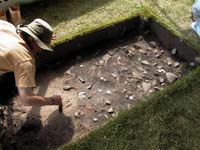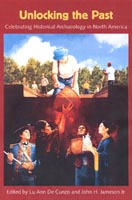The
Past Belongs to Us All
John Triggs

Student archaeologist Joel Bourne excavating an 1840s midden deposit from the military establishment at Penetanguishene on Georgian Bay, Ontario. (Courtesy of John Triggs).
It’s been said that if every child followed their adolescent aspirations, the world would be populated with archaeologists, paleontologists, and professional athletes. The fascination with what came before, the mystery of what lies buried below (and the allure of thousands of people cheering our athletic prowess), is a shared human trait. Only when the reality of making a living forces itself upon us later in life, do most folks choose to follow other career paths. But a handful doggedly pursue their nascent passion with the past. To those few the rewards are great. We are allowed the luxury of realizing our lifelong ambition. Despite rather minimal material rewards, we have the great benefit of engaging in a lifelong study aimed at answering the questions in which we all share a common interest.
Some of my earliest work was in the city of Kingston, Ontario, at the site
of Fort Frontenac, a late seventeenth-century fur trade post at the eastern
end of Lake Ontario. This urban archaeology project sought to locate the
walls of the masonry fort and any artifacts that would provide insight into
one of the earliest European settlements west of Quebec City. The Ontario
Heritage Foundation funded the project, designed purely as a research project;
no development or other activities threatened the land for the foreseeable
future. From the beginning, we used careful excavation techniques, removing
each layer separately by trowel, and we drew, photographed, and documented
all layers and features with copious notes. We did not use mechanical equipment.
Perhaps the most memorable aspect of the Fort Frontenac project was the
stunning revelation that the walls, which everyone had assumed that railways,
roads, and other urban encroachments would have completely eradicated, lay
only twenty-five centimeters (about ten inches) below the ground surface.
The story at many urban sites is the same: archaeological remains of the
city’s earliest inhabitants lie intact often only inches below our
feet. Mary Praetzellis working in West Oakland, California, and Bill Moss,
working in Quebec, found similar cases of archaeological survival in surprisingly
shallow contexts.
The “stories” constructed by historical archaeologists are not simply vignettes of a particular time and place. We must place these individual historical episodes within a larger context to fully appreciate their significance, whether on a regional or global scale. They stand nonetheless as individual segments of a much larger story, which everyone can identify with in one way or another. You may make this connection to the past by virtue of being a newly arrived immigrant, or on the basis of your ethnicity, gender, or class. However each of us makes the connection, it is these shared experiences that remind us that the past belongs to us all.
About the Author:
John Triggs is Assistant Professor of Archaeology and Classical Studies at Wilfrid Laurier University.
